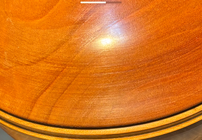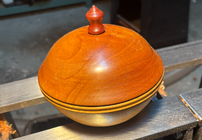Hope I don’t lose my hair imitating Richard Raffan making a box when I turned this today. It finished out nicely but I can see sanding swirls upon close examination. I can rechuck it without leaving chuck marks and refinish the surface. I’m thinking the course grit sandpaper was the culprit. Also this was a practice project so any helpful advice is appreciated.
If this was you, how would you fix it?
As a side note, my friend and local mentor Gerald Lawrence stopped by the other day to give me a lesson on sharpening bowl gouges. Fortunately I had that figured out before he got here so he gave me a tutorial on roughing out green bowls using my freshly sharpened bowl gouges. He also checked out my new lathe.
He also brought me a piece of Ipe which I’m trying to figure out how to purpose and a piece of bloodwood which I made the finial for the lid of the box. It’s also funny how 2 pieces of cherry are different colors.
If this was you, how would you fix it?
As a side note, my friend and local mentor Gerald Lawrence stopped by the other day to give me a lesson on sharpening bowl gouges. Fortunately I had that figured out before he got here so he gave me a tutorial on roughing out green bowls using my freshly sharpened bowl gouges. He also checked out my new lathe.
He also brought me a piece of Ipe which I’m trying to figure out how to purpose and a piece of bloodwood which I made the finial for the lid of the box. It’s also funny how 2 pieces of cherry are different colors.
Attachments
Last edited:



